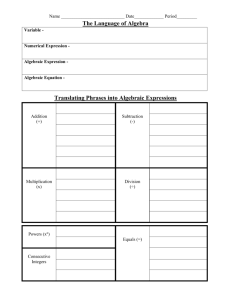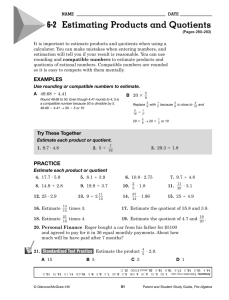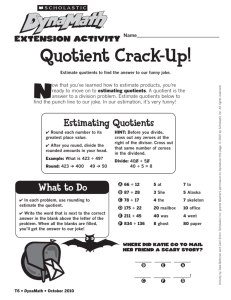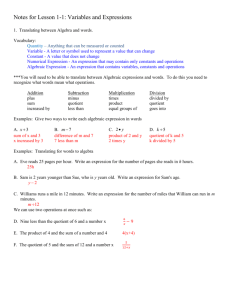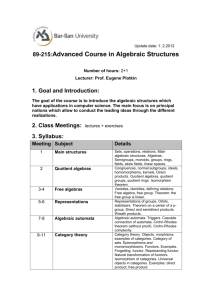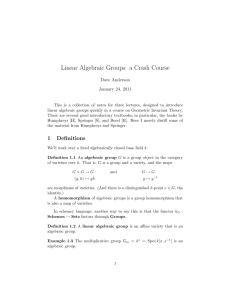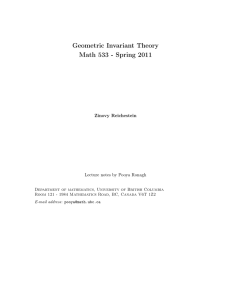SEMINAR QUOTIENTS AND MODULI: Schedule: Mo 16
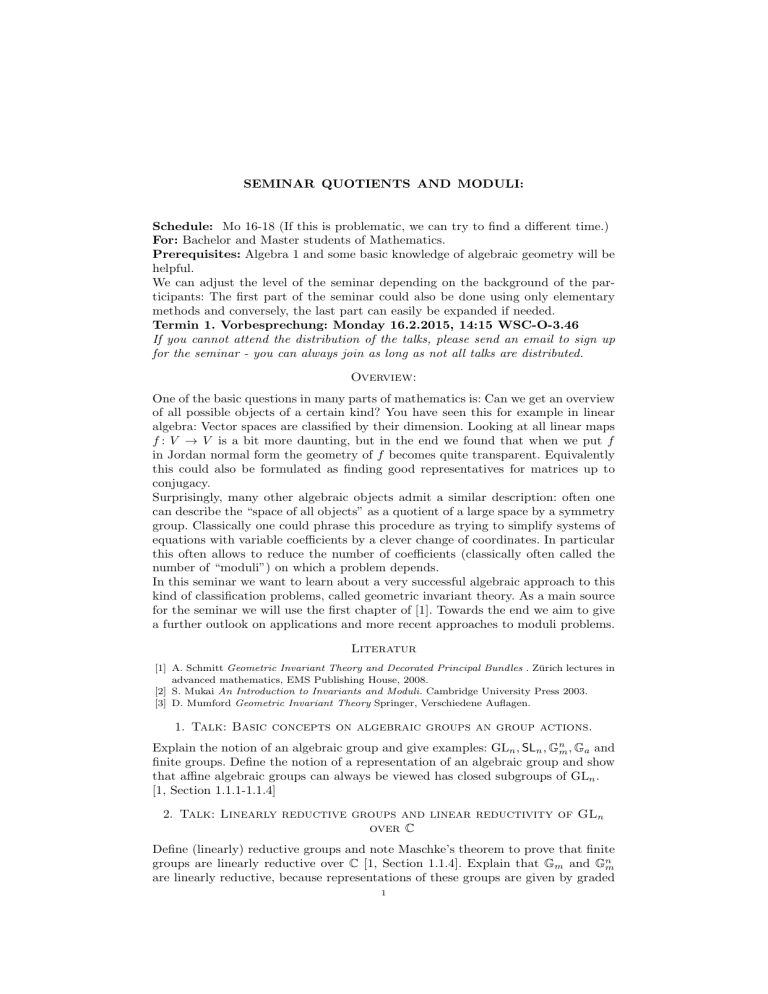
SEMINAR QUOTIENTS AND MODULI:
Schedule: Mo 16-18 (If this is problematic, we can try to find a different time.)
For: Bachelor and Master students of Mathematics.
Prerequisites: Algebra 1 and some basic knowledge of algebraic geometry will be helpful.
We can adjust the level of the seminar depending on the background of the participants: The first part of the seminar could also be done using only elementary methods and conversely, the last part can easily be expanded if needed.
Termin 1. Vorbesprechung: Monday 16.2.2015, 14:15 WSC-O-3.46
If you cannot attend the distribution of the talks, please send an email to sign up for the seminar - you can always join as long as not all talks are distributed.
Overview:
One of the basic questions in many parts of mathematics is: Can we get an overview of all possible objects of a certain kind? You have seen this for example in linear algebra: Vector spaces are classified by their dimension. Looking at all linear maps f : V → V is a bit more daunting, but in the end we found that when we put f in Jordan normal form the geometry of f becomes quite transparent. Equivalently this could also be formulated as finding good representatives for matrices up to conjugacy.
Surprisingly, many other algebraic objects admit a similar description: often one can describe the “space of all objects” as a quotient of a large space by a symmetry group. Classically one could phrase this procedure as trying to simplify systems of equations with variable coefficients by a clever change of coordinates. In particular this often allows to reduce the number of coefficients (classically often called the number of “moduli”) on which a problem depends.
In this seminar we want to learn about a very successful algebraic approach to this kind of classification problems, called geometric invariant theory. As a main source for the seminar we will use the first chapter of [1]. Towards the end we aim to give a further outlook on applications and more recent approaches to moduli problems.
Literatur
[1] A. Schmitt Geometric Invariant Theory and Decorated Principal Bundles . Z¨ advanced mathematics, EMS Publishing House, 2008.
[2] S. Mukai An Introduction to Invariants and Moduli.
Cambridge University Press 2003.
[3] D. Mumford Geometric Invariant Theory Springer, Verschiedene Auflagen.
1.
Talk: Basic concepts on algebraic groups an group actions.
Explain the notion of an algebraic group and give examples: GL n
, SL n
,
G n m
,
G a and finite groups. Define the notion of a representation of an algebraic group and show that affine algebraic groups can always be viewed has closed subgroups of GL n
.
[1, Section 1.1.1-1.1.4]
2.
Talk: Linearly reductive groups and linear reductivity of GL n over C
Define (linearly) reductive groups and note Maschke’s theorem to prove that finite groups are linearly reductive over
C
[1, Section 1.1.4]. Explain that
G m and
G n m are linearly reductive, because representations of these groups are given by graded
1
2 SEMINARTOPOLOGIE vector spaces ([2, Proposition 4.7]). State the theorem that GL n and SL n are linearly reductive over
C
([2, Theorem 4.43,Corollary 4.44]). We will only prove the result for SL
2
. One good way to prove this is explained in [2, Section 4.5]. This also indicates, what notion of reductivity one can use for fields k =
C
.
(The case SL
2 is often the key point in this theory. One can generalize this approach to cover all examples, but it is probably more important to understand this example well.)
3.
Talk: Invariants and Quotients — a first encounter
Once we know that GL n is reductive we can go back to the original problem. Define the categorical quotient of a vector space. [1, Section 1.2.1] and prove Hilbert’s theorem on finite generation ([2, Theroem 4.51-4.5.3] or [1, 1.4.2.2 and its proof].
This allows us to write down the first candidate for a quotient space.
Give one example where this quotient is too small [1, Section 1.2.1] and one example, where the quotient is well behaved (e.g.
e.g.
G m acting on
A
2
S n acting on by t
˙( x, y ) := ( tx, t − 1 y ), or GL
A n n
, or at least not too bad, acting by conjugation on
Mat ( n × n ).
4.
Talk: Different notions of quotients
Explain the notions of a good quotient, a geometric quotient and a categorical quotient [1, Section 1.4.1]. It may be good to recall the example of
A n +1 k
−{ 0 } →
P here. Prove [1, Theorem 1.4.2.4] showing that affine quotients are good quotients.
n
5.
Talk: A first encounter with GIT and Examples (1 or 2 Talks)
State the Hilbert-Mumford criterion [1, Section 1.2] and give more concrete examples how invariants allow us to classify objects. Explain the results on binary forms and ternary cubics. If we find 2 speakers we will also include basic results on representations of quivers. [1, Section 1.3].
6.
Talk: Linearizations and semistability
Section 1.4.3 of [1]. Define what a linearization of an action on a line bundle is
(this is simply the notion of extending an action on a scheme X to a line bundle on
X ). We take Theorem 1.4.3.3 as definition of ample line bundles. Prove Theorem
1.4.3.7, which explains stable points on projective varieties.
7.
Talk: Existence of quotients.
Prove the main theorem on existence of quotients [1, Theorem 1.4.3.8] and give some of the examples from Page 60-62.
8.
Talk The Hilbert-Mumford criterion
State and prove Theorem 1.5.1.4 of [1]. This gives an effective numerical criterion to determine semistable points of an action.
9.
Talk: More examples
Give more examples of quotients, e.g. Grassmannians [2, Section 8.1] and sets of points in
P n
[2, Section 7.2.(c)].
SEMINARTOPOLOGIE 3
10.
Talk: Recollection on line bundles and divisors on curves
In this talk you should recall the basic results on line bundles and divisors on curves. We need: The definition of divisors and the fact that every line bundle on a smooth curve comes from a divisor and we need to define the degree of a divisor.
From Algebraic Geometry we will use without proof that line bundles of sufficiently high degree are generated by their global sections. (The speaker for this talk should discuss the precise content and references with me, as these will depend on your background.)
11.
Talk: Construction of the Jacobian by GIT
This talk should explain that the group of line bundles of degree 0 on a curve is the set of points of a k -scheme following [2, Section 9.2, page 316-322].
12.
Talk: The Jacobian as a functor (probably 2 talks)
State and explain the theorem that the Jacobian represts a functor [2, Theorem
11.1]. Deduce the corollary that 11.2 that the Jacobian is a group scheme. Explain section 11.1.(a) and (c). A key ingredient here comes from cohomology and we will use this without proof as you can learn about it in the algebraic geometry course.

